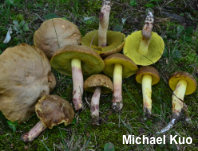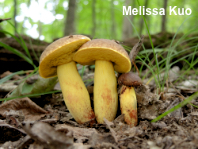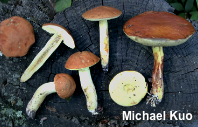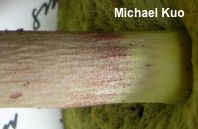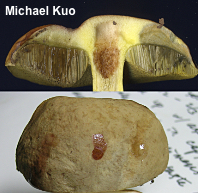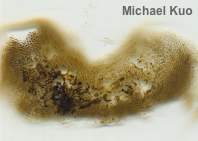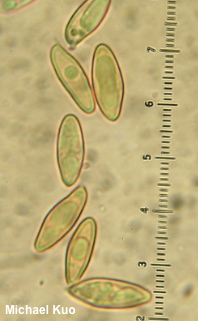| Major Groups > Boletes > Leccinum > Hemileccinum subglabripes |

|
Hemileccinum subglabripes [ Basidiomycota > Boletales > Boletaceae > Hemileccinum . . . ] by Michael Kuo Hemileccinum subglabripes grows under oaks in the southern part of its range, and under birch or aspen in its northern range. Its stem is fairly long and slender, and its proportions are usually more Leccinum-like than Boletus-like. The yellow stem surface is adorned with scabers like those found in Leccinum, but in Hemileccinum subglabripes the scabers are inconspicuous and tiny, usually best observed with a hand lens; Peck's species name subglabripes, Latin for "nearly smooth-stemmed," is very appropriate—as is his comment that "the branny particles on the stem are pale and easily overlooked" (1889, p. 112). The flesh is yellow, and it does not change color dramatically when sliced (though it may turn slightly reddish and/or pale blue in a few spots). The cap is brown to cinnamon brown or orangish brown, and its surface is bald, sometimes developing a slightly wrinkled appearance. Hemileccinum hortonii is very similar, but has a consistently corrugated cap surface that turns green with a drop of ammonia, and different terminal cells in the pileipellis. Boletus subglabripes and Leccinum subglabripes are synonyms, as is Boletus flavipes. Thanks to Sibylla Brown for documenting, collecting, and preserving Hemileccinum subglabripes for study; her collection is deposited in The Herbarium of Michael Kuo. Description: Ecology: Mycorrhizal with hardwoods, including birch, aspen, oaks, and hickories; appearing alone or gregariously; summer and fall; widely distributed in northern and eastern North America; also appearing in the northern Rocky Mountains. The illustrated and described collections are from Iowa, Illinois, Michigan, and Minnesota. Cap: 3–10 cm; convex, becoming broadly convex; dry; bald, or occasionally very slightly velvety when young; smooth or occasionally a little wrinkled; brown to olive brown or orangish brown when young, maturing to medium brown, paler olive brown, reddish brown, orangish brown, or tan; without a sterile overhanging margin. Pore Surface: Bright yellow when young, becoming olive yellow to dirty green; not bruising; 1–3 angular pores per mm at maturity; tubes to 15 mm deep; by maturity usually depressed at the stem. Stem: 4.5–10 cm long; 1–2 cm thick; fairly equal; often a little curved near the base; occasionally tapered to a somewhat rooting base; very finely scabrous with tiny (use a lens) scabers that are initially yellow but mature to reddish; overall appearing yellow at first, then slowly developing red colors from the base upwards; very rarely bruising a little bluish; basal mycelium white. Flesh: Pale yellow or rarely whitish in cap; dark yellow in stem; not staining on exposure—or staining slowly slightly pinkish or, occasionally, pale blue; sometimes red in the stems of older specimens. Odor and Taste: Odor not distinctive; taste slightly sour. Chemical Reactions: Ammonia pink or negative on cap surface; often pale blue on flesh after some time, but also sometimes negative (but never flashing green; compare to Hemileccinum hortonii). KOH orangish to red or gray on cap surface; orangish on flesh. Iron salts negative on cap; usually grayish to bluish gray on flesh but occasionally negative. Spore Print: Olive brown. Microscopic Features: Spores 12–16 x 4–6 µm; fusiform; smooth; yellowish in KOH. Basidia clavate; 4-sterigmate. Hymenial cystidia scattered; inconspicuous; to about 35 x 12.5 µm; lageniform; smooth; thin-walled; hyaline in KOH. Pileipellis a trichoderm of inflated, chained elements (an epithelium) 10–25 µm wide, smooth, thin-walled, hyaline to yellowish in KOH; terminal cell usually subglobose but occasionally subfusiform or tapering-irregular and smaller than the subterminal cell. Caulocystidia clavate to lageniform; up to 50 x 25 µm; hyaline in KOH. REFERENCES: (Peck, 1889) Halling, 2015. (Coker & Beers, 1943; Singer, 1947; Smith & Thiers, 1968; Snell & Dick, 1970; Smith & Thiers, 1971; Smith, 1975; Grund & Harrison, 1976; Smith, Smith & Weber, 1981; Phillips, 1991/2005; Both, 1993; Barron, 1999; Bessette et al., 2000; den Bakker & Noordeloos, 2005; McNeil, 2006; Kuo, 2007; Kuo & Methven, 2014; Bessette et al., 2016; Baroni, 2017; Kuo & Ortiz-Santana, 2020.) Herb. Kuo 07199401, 08029503, 06130209, 08160504, 08240506, 07020704, 07070702, 08310702, 07230802, 08180901, 09010901, 08301402, 08251906. This site contains no information about the edibility or toxicity of mushrooms. |
|
|
Cite this page as: Kuo, M. (2020, January). Hemileccinum subglabripes. Retrieved from the MushroomExpert.Com Web site: http://www.mushroomexpert.com/hemileccinum_subglabripes.html © MushroomExpert.Com |
